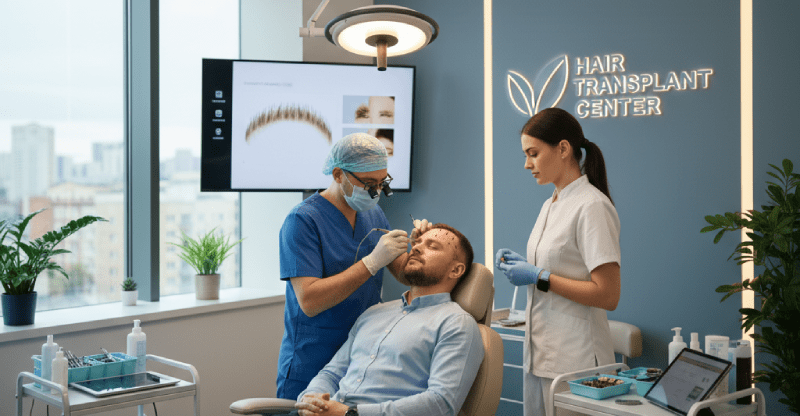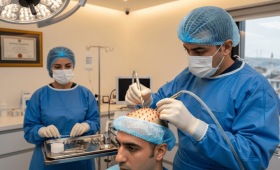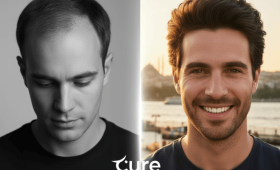Hair loss is one of the most common aesthetic problems of the modern era, and it can negatively affect individuals’ self-confidence and social life. Fortunately, with advances in medicine, hair transplantation has become a popular aesthetic procedure that offers a permanent and natural solution to this problem. In this article, we will examine one of the most common hair transplant methods, robotic hair transplantation (ARTAS), and other popular methods in detail.
What is Hair Transplantation?
Hair transplantation is essentially the surgical transfer of hair follicles, which are genetically resistant to shedding, from the back of the head (the nape area) to areas that are bald or have thinning hair. The nape area, also known as the donor area, is chosen because it is genetically resistant to hair loss. The goal of the operation is to achieve a natural and permanent hair density in the areas where hair loss has occurred. The transferred hair follicles retain their permanence in their new locations and continue to grow for a lifetime.
Who is a Good Candidate for Hair Transplantation?
A hair transplant operation is generally suitable for healthy individuals over the age of 20 who have reached a certain level of hair loss. One of the most important criteria for the success of the operation is the presence of a sufficient number and quality of healthy hair follicles in the donor area from which the hair will be taken. This operation may not be suitable for people with chronic diseases or serious health problems. In addition, the type and cause of hair loss also play an important role in determining suitability for hair transplantation. Therefore, every candidate must undergo a detailed medical evaluation before the operation.
Hair Transplant Methods: FUE and FUT
Although hair transplant technology has evolved over the years, there are two main methods used: FUE (Follicular Unit Extraction) and FUT (Follicular Unit Transplantation). The FUE method is based on the collection of hair follicles one by one, while the FUT method is based on the removal of a strip of scalp and the separation of the follicles from this strip. Today, FUE has become the most preferred method due to its minimally invasive nature and less scarring. FUT can still be used for larger balding areas and in some special cases.
How is the FUE Method Applied?
The FUE (Follicular Unit Extraction) method is a modern technique that allows for the collection of hair follicles one by one. In this procedure, the hair transplant specialist uses special tools called micromotors or manual punches to gently extract hair follicles from the donor area one by one.
Each hair follicle (graft) can contain one to four hairs. These grafts are collected without damage and then placed into the micro-channels in the area where the transplant will be performed. The biggest advantage of FUE is that it leaves almost no scarring in the donor area after the operation and offers a quick recovery process.
How is the FUT Method Applied?
Although the FUT (Follicular Unit Transplantation) method is an older technique, it can still be preferred in some cases. In this method, the surgeon surgically cuts and removes a strip of scalp from the donor area. This strip is then divided into small grafts (groups of hair follicles) under a microscope.
These grafts are then placed in the area of hair loss. The most significant disadvantage of FUT is the potential for a permanent and noticeable scar where the strip was taken. It is also a more invasive surgical procedure than FUE, and the recovery period may be slightly longer.
What is Robotic Hair Transplantation (ARTAS)?
Robotic hair transplantation is one of the most advanced technological versions of the FUE method. The ARTAS Robotic Hair Transplant System performs the hair follicle extraction stage with the precision of a robot. This system, which aims to minimize human error, completely automates the FUE technique to collect hair follicles. Thanks to advanced imaging technology and algorithms, it analyzes the donor area and aims to improve the quality of the operation by selecting only the most suitable grafts. This technology makes the operation process more predictable and standardized.
How Does the ARTAS System Work?
The ARTAS system works with high-resolution digital imaging and special artificial intelligence algorithms. The robot creates a 3D map of the donor area to identify the strongest and healthiest hair follicles. It calculates the angle, direction, and depth of these grafts with millimeter precision.
Then the robotic arms, using a special punch tool, extract these grafts flawlessly. This automation minimizes the risk of damage to the grafts and increases the speed and consistency of the operation. This technology eliminates surgeon fatigue, ensuring the highest level of precision throughout all stages of the operation.
Advantages of Robotic Hair Transplantation
Robotic hair transplantation (ARTAS) offers many important advantages. First, it minimizes human error because the robot performs every movement with predetermined algorithms. This reduces the risk of graft damage and ensures higher survival rates. The precision of the robotic system causes less trauma to the donor area, which means a faster recovery. In addition, the graft extraction process is completed much faster and more consistently, which can shorten the operation time and provide a more comfortable experience for patients.

Disadvantages of Robotic Hair Transplantation
While robotic hair transplantation offers many advantages, it also has some disadvantages. One of the most significant disadvantages is the higher cost of the operation. The use of advanced technology and the cost of the system make this method more expensive than other FUE techniques. In addition, robotic systems may not be suitable for all types of hair and hair structures. The robot’s precision may not be sufficient for very curly or fine hair. Furthermore, the transplantation stage of the operation is usually still done manually, so the robot’s capabilities are limited.
What is DHI Hair Transplantation?
DHI (Direct Hair Implantation) is considered an advanced version of FUE and represents a revolution in hair transplantation. In this method, hair follicles are collected from the donor area, but they are directly placed into the area to be transplanted with a special Choi Pen (implanter pen) without opening micro-channels. The Choi Pen performs both the channel opening and graft placement functions in a single motion. This way, hair follicles spend less time outside the body, and their survival rates increase. The DHI technique offers the possibility of a denser transplant and provides more control over hairline design.
Advantages of the DHI Method
The DHI method offers many important advantages. First, since hair follicles spend less time outside, the risk of the follicles losing their vitality decreases, which ensures higher graft survival rates. Second, thanks to the DHI pens, no channels are opened during the transplant, which means minimal trauma and a faster recovery. This technique also allows for transplantation between existing hairs, which is ideal for unshaven FUE. It helps to achieve a denser and more natural look.
Disadvantages of the DHI Method
The DHI method also has some disadvantages. This method can take longer than other hair transplant techniques because each hair follicle needs to be placed one by one with great precision. This can increase the cost of the operation. Additionally, the DHI technique requires a highly experienced team that has specialized in using this specific pen. DHI operations performed by inexperienced teams can result in graft damage or incorrect angle placement. Therefore, choosing the right clinic and team for a DHI operation is of great importance.
Which is the Best Hair Transplant Method?
It is not correct to define a single “best” hair transplant method. This is because each person’s hair loss condition, donor area capacity, hair type, and personal expectations are different. For example, DHI may be more suitable for minimal hair loss, while FUE may be more efficient for large balding areas.
Robotic hair transplantation, on the other hand, can be appealing to those who seek precision and consistency. Therefore, determining the best method is not about looking at the advantages of just one method but is only possible through a detailed consultation with a hair transplant specialist who can analyze your specific situation.
Which Method is Right for Me?
To understand which hair transplant method is right for you, you should first have a comprehensive consultation with a hair transplant specialist. The specialist will evaluate the structure of your hair and scalp, the cause and degree of your hair loss, the adequacy of your donor area, and your general health condition.
For example, if your donor area is too weak, no method may be suitable. The specialist will also recommend the most suitable method for you by considering your desired results and budget. This consultation is of vital importance for the success of the operation and your satisfaction.
Pre-Hair Transplant Preparation Process
Before the hair transplant operation, it is important to follow certain steps to achieve successful results and minimize risks. These steps include quitting alcohol and smoking at least one week before the operation, avoiding blood-thinning medications like aspirin, and informing your doctor about herbal supplements. It is also important to wear comfortable clothes on the day of the operation and keep your hair clean. Strictly following all instructions given by your doctor will ensure a safe and successful operation.
How Long Does a Hair Transplant Operation Take?
The duration of a hair transplant operation can vary depending on many factors. The most important factor is the number of grafts to be transplanted. For example, a small operation of 2000 grafts can take 4-5 hours, while for 5000 grafts or more, the operation time can extend up to 8-10 hours. The method used also affects the duration; the DHI method generally takes longer than FUE. During the operation, the patient can take breaks and rest, which may slightly prolong the total duration. This process is important for the patient’s comfort and the quality of the operation.
Post-Hair Transplant Recovery Process
The post-hair transplant recovery process depends on how well the patient follows the post-operative instructions. For the first few days, redness, swelling, and mild pain may be seen in both the donor and transplanted areas. This is normal and can be managed with medication prescribed by the doctor. Crusts will form within the first 10 days and these crusts will fall off with regular washing. A full recovery, meaning the skin color returns to normal and minimal scars are visible, takes a few weeks. Being careful during this period is essential for a successful outcome.
Post-Hair Transplant Care and Washing
The first wash after a hair transplant is usually done by specialists at the clinic 2-3 days after the operation. This first wash is performed with great care to avoid damaging the transplanted area. Patients are given detailed instructions on how to wash their hair in the following days. A special lotion and shampoo are generally used. During the hair washing process, it is very important to be gentle with the transplanted area, avoid direct water pressure, and not massage the area. Adhering to this care routine is vital for the proper settling and growth of the transplanted hair follicles.

What is Shock Loss?
After a hair transplant operation, the shedding of approximately 80% of the transplanted hair between 2 and 8 weeks is called “shock loss.” This is a completely normal situation caused by the hair follicles reacting to the trauma and entering a resting phase. This shedding is not of the follicles themselves but only of the hair strands. While it may seem alarming to patients, this process does not mean the operation has failed. On the contrary, it is an indicator that the hair follicles are adapting to their new location and preparing to produce new and permanent hair.
The Growth of New Hair
Following the shock loss phase, new hair begins to grow from the transplanted hair follicles. This process usually starts after 3 to 4 months. Initially, the new hair may be thin and lifeless. However, over time, the hair will strengthen and thicken. About 50-60% of the hair usually grows within 6 months. The final and complete result of the operation is expected to be seen after 12 to 18 months. During this process, being patient and following the doctor’s advice is crucial to achieve the best result.
The Naturalness of Hair Transplant Results
The success of a hair transplant is not only measured by the number of grafts transplanted but also by how natural the result looks. For a natural appearance, the hair transplant specialist must place the hair follicles at the correct angle and direction, design the hairline to suit the person’s face shape, and distribute the grafts with a natural density. An experienced team can manage these factors to provide a natural look that is undetectable. Therefore, the experience of the clinic and the team performing the operation is of critical importance.
Cost of a Hair Transplant Operation
The cost of a hair transplant operation varies widely depending on several factors. The most important factors affecting the cost include the number of grafts to be transplanted, the chosen hair transplant technique (FUE, DHI, robotic transplantation), the location of the country and clinic where the operation is performed, the experience of the team, and additional services offered with the operation (accommodation, transfer, etc.). Each factor has a direct impact on the total cost. Therefore, when getting a price, it is important to ask in detail what services are included in that price.
Hair Transplant Tourism in Turkey
Turkey has become a global hub for hair transplantation, which is one of the main reasons it is a top destination in the medical tourism sector. The most important factors behind this popularity are the operations being offered at more affordable prices compared to other countries, the presence of specialized and experienced surgeons, modern clinics with the latest technology, and high service quality. In addition, the comprehensive packages offered by hospitals, along with additional services like accommodation and transfer, make the process easier for international patients.
Choosing a Specialist for Hair Transplantation
Choosing the right specialist is as important as the operation itself for a successful hair transplant. The most critical points to consider when choosing a specialist are the doctor’s experience, before and after pictures of their previous operations, their area of expertise, and their communication with patients. It is also necessary to consider the clinic’s accreditations, the modernity of its equipment, and the professionalism of the team. A good specialist will explain not only the operation but also the entire process transparently and help you set realistic expectations.
Psychological Effects of Hair Transplantation
Hair loss can deeply affect an individual’s self-confidence and social life. A successful hair transplant operation not only provides a physical change but also positively transforms these psychological effects. Individuals who regain their hair can feel younger and more attractive, which leads to increased self-confidence and allows them to move more comfortably in social settings. Hair transplantation is an important step that has the potential to improve a person’s quality of life and general happiness.
Beard and Mustache Transplantation
Hair transplant techniques can be applied not only for hair loss on the head but also for men with sparse or patchy beards and mustaches. In this operation, hair follicles are usually taken from the donor area (the nape) and transplanted to the beard or mustache area. The transplanted hair follicles in these areas also grow like natural beard and mustache hairs and remain permanent for a lifetime. The operation aims to give the person a fuller and more masculine appearance.
Eyebrow Transplantation
Eyebrow transplantation offers a natural solution for individuals with sparse or completely missing eyebrows due to various reasons (genetics, injury, over-plucking, etc.). In this operation, hair follicles taken from the donor area, as in hair transplantation, are transplanted to the eyebrow area one by one and with great care. Since eyebrow transplantation greatly affects facial expression, the angle and direction of the grafts must be adjusted with great precision during the procedure. As a result, a natural and aesthetic eyebrow structure that suits the person’s facial features is achieved.
Differences Between Hair Transplant Methods
The main differences between hair transplant methods are the way hair follicles are collected and transplanted. FUE collects hair follicles one by one, while FUT takes a strip of tissue. DHI performs both the channel opening and transplantation with a single tool. Robotic transplantation, as a sub-type of FUE, performs the hair follicle extraction with the precision of a robot. Each method has different advantages and disadvantages. These differences become apparent in terms of recovery time, scarring potential, cost, and the density of the result to be achieved.
The Future of Hair Transplantation
Hair transplant technology continues to advance with new developments every day. The further development of robotic systems and the increase in artificial intelligence integration will make operations more precise and personalized. Furthermore, research into technologies like stem cell therapy and cloning may offer new and revolutionary solutions for hair transplantation in the future. These developments promise new hope for individuals with insufficient donor areas and also make operations less invasive.
Conclusion: Taking the Right Step
Hair transplantation is an important decision that can improve one’s quality of life. When making this decision, it is crucial to access the right information and consult with a specialist team in the field. Remember that every individual’s situation is unique, and a personalized treatment plan should be created for you. To get more detailed information about hair transplantation and evaluate your personal situation, you can contact a reliable medical tourism company that offers services in this field.



